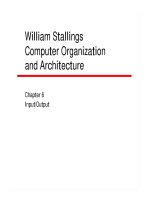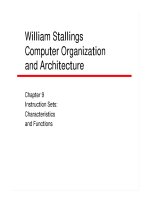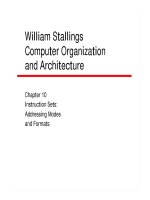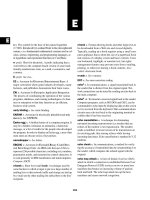Computer Organization and Architecture phần 4 pptx
Bạn đang xem bản rút gọn của tài liệu. Xem và tải ngay bản đầy đủ của tài liệu tại đây (811.8 KB, 10 trang )
31
Universidade do Minho – Dep. Informática - Campus de Gualtar – 4710-057 Braga - PORTUGAL-
William Stallings, “Computer Organization and Architecture”, 5th Ed., 2000
o In a split cache, one cache is dedicated to instructions, and one cache is dedicated to
data
§ trend is toward split cache because of superscalar CPU’s
§ better for pipelining, prefetching, and other parallel instruction execution
designs
§ eliminates cache contention between instruction processor and the execution
unit (which uses data)
Pentium Cache Organization (4.4 + …)
• Evolution
o 80386 - No on-chip cache
o 80486 - unified 8Kbyte on-chip cache (16 byte line, 4-way set associative)
o Pentium - two 8Kbyte on-chip caches split between data and instructions (32 byte line,
two-way set associative)
o Pentium Pro/II – 8K, 32 byte line, 4-way set associative instruction cache and 8K, 32
byte line, 2-way set associative data cache, plus a L2 cache on a dedicated local bus
feeding both.
32
Universidade do Minho – Dep. Informática - Campus de Gualtar – 4710-057 Braga - PORTUGAL-
William Stallings, “Computer Organization and Architecture”, 5th Ed., 2000
• Data Cache Internal Organization
o Basics
§ Ways
§ 128 sets of two lines each
§ Logically organized as two 4Kbyte “ways” (each way contains one
line from each set, for 128 lines per way)
§ Directories
§ Each line has a tag taken from the 20 most significant bits of the
memory address of the data stored in the corresponding line
§ Each line has two state bits, one of which is used to support a write-
back policy (write-through can be dynamically configured)
§ Logically organized as 2 directories, corresponding to the ways (one
directory entry for each line)
§ LRU support
§ Cache controller uses a least-recently-used replacement policy
§ A single array of 128 LRU bits supports both ways (one bit for each
set of two lines)
§ Level-2 cache is supported
§ May be 256 or 512 Kbytes
§ May use a 32-, 64-, or 128-byte line
§ Two-way set associative
• Data Cache Consistency
o Supports MESI protocol
§ Supported by the two state bits mentioned earlier
§ Each line can be in one of 4 states:
§ Modified - The line in the cache has been modified and is available
only in this cache
§ Exclusive - The line in the cache is the same as that in main memory
and is not present in any other cache
§ Shared - The line in the cache is the same as that in main memory
and may be present in another cache
§ Invalid - The line in the cache dopes not contain valid data
§ Designed to support multiprocessor organizations, but also useful for
managing consistency between L1 and L2 caches in a single processor
organization.
§ In such an organization, the L2 cache acts as the “memory” that is
cached by the L1 cache.
§ So when MESI refers to a line being “the same as memory” (or not), it
may be referring to the contents of another cache.
PowerPC Cache Organization (… 4.4)
• Evolution
o PowerPC 601 - Unified 32Kbyte on-chip cache (32 byte line, 8-way set associative)
o PowerPC 603 - two 8Kbyte on-chip caches split between data and instructions (32
byte line, two-way set associative)
o PowerPC 604 - two 16Kbyte on-chip caches split between data and instructions (32
byte line, 4-way set associative)
o PowerPC 620 - two 32Kbyte on-chip caches split between data and instructions (64
byte line, 8-way set associative)
33
Universidade do Minho – Dep. Informática - Campus de Gualtar – 4710-057 Braga - PORTUGAL-
William Stallings, “Computer Organization and Architecture”, 5th Ed., 2000
• External Organizational Features
o Code cache
§ Mostly ignored here see chap. 12 for detail
§ Read-only
o Data cache
§ uses a load/store unit to feed both floating point unit and any of the 3 parallel
integer ALU’s
§ Uses MESI, but adds Allocated (A) state - used when a block of data in a line
is swapped out and replaced.
Advanced DRAM Organization (4.5)
• Fast Page Mode (FPM DRAM)
o A row of memory cells (all selected by the same row address) is called a page
o Only the first access in a page needs to have the row address lines precharged
o Successive accesses in the same page require only precharging the column address
lines
o Supports bus speeds up to about 28.5Mhz (w/ 60ns DRAM’s)
• Extended Data Out (EDO RAM)
o Just like FPM DRAM, except that the output is latched into D flip-flops (instead of just
being line transitions)
o This allows row and/or column addresses for the next memory operation to be loaded
in parallel with reading the output (because the flip-flops will not change until they
receive a change signal)
o Supports bus speeds up to about 40Mhz (w/ 60ns DRAM’s)
• Burst EDO (BEDO RAM)
o Allows bursting of sequential data, and independent generation of next addresses, so
that only the first access needs row/column addresses from bus
34
Universidade do Minho – Dep. Informática - Campus de Gualtar – 4710-057 Braga - PORTUGAL-
William Stallings, “Computer Organization and Architecture”, 5th Ed., 2000
o Supports bus speeds up to 66Mhz
• Enhanced DRAM
o Developed by Ramtron
o Integrates a small SRAM cache which stores contents of last 512-nibble row read
o Refresh is in parallel to cache reads
o dual ported - reads can be done in parallel with writes
• Cache DRAM
o Developed by Mitsubishi
o Similar to EDRAM, but:
§ uses a larger cache - 16K vs. 2K
§ uses a true cache, consisting of 64-bit lines
§ cache can also be used as a buffer to support the serial access of a block of
data
• Synchronous DRAM
o Developed jointly by several manufacturers
o Standard DRAM is asynchronous
§ Memory controller watches for read request and address lines
§ After request is made, bus master must wait while DRAM responds
§ Bus master watches acknowledgment lines for operation to complete (and
must wait in the meantime)
o Synchronous DRAM moves data in an out in a set number of clock cycles,
synchronized with the system clock, just like the processor
o Other speedups
§ burst mode - after first access, no address setup or row/column line
precharge time is needed
§ dual-bank internal architecture improves opportunities for on-chip parallelism
§ mode register allows burst length, burst type, and latency (between receipt of
a read request and beginning of data transfer) to be customized to suit
specific system needs
o Current standard works with bus speeds up to 100Mhz (while bursting), or 75Mhz for
so-called SDRAM Lite.
• Rambus DRAM
o Developed by Rambus
o Vertical package, all pins on one side, designed to plug into the RDRAM bus (a
special high speed bus just for memory)
o After initial 480 ns access time, provides burst speeds of 500 Mbps (compared w/
about 33 Mbps for asynchronous DRAM’s)
• RamLink
o Developed as part of the IEEE working group effort called Scalable Coherent Interface
(SCI)
o DRAM chips act as nodes in a ring network
o Data is exchanged in packets
§ Controller sends a request packet to initiate mem transaction, containing cmd
header, address, checksum, and data to be written (if a write). Extra data in
cmd header allows more efficient access.
o Supports a small or large number of DRAM’s
o Does not dictate internal DRAM structure
35
Universidade do Minho – Dep. Informática - Campus de Gualtar – 4710-057 Braga - PORTUGAL-
William Stallings, “Computer Organization and Architecture”, 5th Ed., 2000
II. THE COMPUTER SYSTEM.
3.
4.
5. External Memory. (28-Mar-00)
RAID (5.2)
Redundant Arrays of Independent Disks
Three Common (mostly) Characteristics
• RAID is a set of physical disk drives viewed by the operating system as a single logical drive.
• Data are distributed across the physical drives of an array.
• Redundant disk capacity is used to store parity information, which guarantees data
recoverability in case of a disk failure.* * Except for RAID level 0.
Level 0 (Non-redundant)
• Not a true member of RAID – no redundancy!
• Data is striped across all the disks in the array
o Each disk is divided into strips which may be blocks, sectors, or some other
convenient unit.
o Strips from a file are mapped round-robin to each array member
o A set of logically consecutive strips that maps exactly one strip to each array member
is a stripe
• If a single I/O request consists of multiple contiguous strips, up to n strips can be handled in
parallel, greatly reducing I/O transfer time.
Level 1 (Mirrored)
• Only level where redundancy is achieved by simply duplicating all the data
• Data striping is used as in RAID 0, but each logical strip is mapped to two separate physical
disks
• A read request can be serviced by disk with minimal seek and latency time
36
Universidade do Minho – Dep. Informática - Campus de Gualtar – 4710-057 Braga - PORTUGAL-
William Stallings, “Computer Organization and Architecture”, 5th Ed., 2000
• Write requests require updating 2 disks, but both can be updated in parallel, so no penalty
• When a drive fails, data may be accessed from other drive
• High cost for high performance
o Usually used only for highly critical data.
o Best performance when requests are mostly reads
Level 2 (Redundancy through Hamming Code)
• Uses parallel access – all member disks participate in every I/O request
• Uses small strips, often as small as a single byte or word
• An error-correcting code (usually Hamming) is calculated across corresponding bits on each
data disk, and the bits of the code are stored in the corresponding bit positions on multiple
parity disks.
• Useful in an environment where a lot of disk errors are expected
o Usually expensive overkill.
o Disks are so reliable that this is never implemented
Level 3 (Bit-Interleaved Parity)
• Uses parallel access – all member disks participate in every I/O request
• Uses small strips, often as small as a single byte or word
• Uses only a single parity disk, no matter how large the disk array
o A simple parity bit is calculated and stored
o In the event of a failure in one disk, the data on that disk can be reconstructed from
the data on the others
o Until the bad disk is replaced, data can still be accessed (at a performance penalty) in
reduced mode
37
Universidade do Minho – Dep. Informática - Campus de Gualtar – 4710-057 Braga - PORTUGAL-
William Stallings, “Computer Organization and Architecture”, 5th Ed., 2000
Level 4 (Block-Level Parity)
• Uses an independent access technique
o each member disk operates independently, so separate I/O requests can be satisfied
in parallel.
o More suitable for apps that require high I/O request rates rather than high data
transfer rates.
• Relatively large strips
• Has a write penalty for small writes, but not for larger ones (because parity can be calculated
from values on other strips)
• In any case, every write involves the parity disk
Level 5 (Block-Level Distributed Parity)
• Like Level 4, but distributes parity strips across all disks, removing the parity bottleneck
Level 6 (Dual Redundancy)
• Like Level 6, but provides 2 parity strips for each stripe, allowing recovery from 2
simultaneous disk failures.
38
Universidade do Minho – Dep. Informática - Campus de Gualtar – 4710-057 Braga - PORTUGAL-
William Stallings, “Computer Organization and Architecture”, 5th Ed., 2000
II. THE COMPUTER SYSTEM.
3.
4.
5.
6. Input/Output. (23-Mar-98)
Introduction
• Why not connect peripherals directly to system bus?
o Wide variety w/ various operating methods
o Data transfer rate of peripherals is often much slower than memory or CPU
o Different data formats and word lengths than used by computer
• Major functions of an I/O module
o Interface to CPU and memory via system bus or central switch
o Interface to one or more peripheral devices by tailored data links
External Devices (6.1)
• External devices, often called peripheral devices or just peripherals, make computer systems
useful.
• Three broad categories of external devices:
o Human-Readable (ex. terminals, printers)
o Machine-Readable (ex. disks, sensors)
o Communication (ex. modems, NIC’s)
• Basic structure of an external device:
o Data - bits sent to or received from the I/O module
o Control signals - determine the function that the device will perform
o Status signals - indicate the state of the device (esp. READY/NOT-READY)
o Control logic - interprets commands from the I/O module to operate the device
o Transducer - converts data from computer-suitable electrical signals to the form of
energy used by the external device
o Buffer - temporarily holds data being transferred between I/O module and the external
device
39
Universidade do Minho – Dep. Informática - Campus de Gualtar – 4710-057 Braga - PORTUGAL-
William Stallings, “Computer Organization and Architecture”, 5th Ed., 2000
I/O Modules (6.2)
• An I/O Module is the entity within a computer responsible for:
o control of one or more external devices
o exchange of data between those devices and main memory and/or CPU registers
• It must have two interfaces:
o internal, to CPU and main memory
o external, to the device(s)
• Major function/requirement categories
o Control and Timing
§ Coordinates the flow of traffic between internal resources and external
devices
§ Cooperation with bus arbitration
o CPU Communication
§ Command Decoding
§ Data
§ Status Reporting
§ Address Recognition.
o Device Communication (see diagram under External Devices)
§ Commands
§ Status Information
§ Data
o Data Buffering
§ Rate of data transfer to/from CPU is orders of magnitude faster than to/from
external devices
§ I/O module buffers data so that peripheral can send/receive at its rate, and
CPU can send/receive at its rate
o Error Detection
§ Must detect and correct or report errors that occur
§ Types of errors
§ Mechanical/electrical malfunctions
§ Data errors during transmission
• I/O Module Structure
o Basic Structure
40
Universidade do Minho – Dep. Informática - Campus de Gualtar – 4710-057 Braga - PORTUGAL-
William Stallings, “Computer Organization and Architecture”, 5th Ed., 2000
o An I/O module functions to allow the CPU to view a wide range of devices in a simple-
minded way.
o A spectrum of capabilities may be provided
§ I/O channel or I/O processor - takes on most of the detailed processing
burden, presenting a high-level interface to CPU
§ I/O controller or device controller - quite primitive and requires detailed control
§ I/O module - generic, used when no confusion results
Programmed I/O (6.3)
• With programmed I/O, data is exchanged under complete control of the CPU
o CPU encounters an I/O instruction
o CPU issues a command to appropriate I/O module
o I/O module performs requested action and sets I/O status register bits
o CPU must wait, and periodically check I/O module status until it finds that the
operation is complete
• To execute an I/O instruction, the CPU issues:
o an address, specifying I/O module and external device
o a command, 4 types:
§ control - activate a peripheral and tell it what to do
§ test - querying the state of the module or one of its external devices
§ read - obtain an item of data from the peripheral and place it in an internal
buffer (data register from preceding illustration)
§ write - take an item of data from the data bus and transmit it to the peripheral
• With programmed I/O, there is a close correspondence between the I/O instructions used by
the CPU and the I/O commands issued to an I/O module
• Each I/O module must interpret the address lines to determine if a command is for itself.
• Two modes of addressing are possible:
o Memory-mapped I/O
§ there is a single address space for memory locations and I/O devices.
§ allows the same read/write lines to be used for both memory and I/O
transactions
o Isolated I/O
§ full address space may be used for either memory locations or I/O devices.
§ requires an additional control line to distinguish memory transactions from I/O
transactions
§ programmer loses repertoire of memory access commands, but gains
memory address space
Interrupt-Driven I/O (6.4)
• Problem with programmed I/O is CPU has to wait for I/O module to be ready for either
reception or transmission of data, taking time to query status at regular intervals.
• Interrupt-driven I/O is an alternative
o It allows the CPU to go back to doing useful work after issuing an I/O command.
o When the command is completed, the I/O module will signal the CPU that it is ready
with an interrupt.
• Simple Interrupt Processing Diagram









